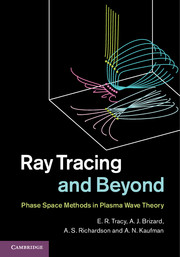Book contents
- Frontmatter
- Dedication
- Contents
- Preface
- Acknowledgements
- 1 Introduction
- 2 Some preliminaries
- 3 Eikonal approximation
- 4 Visualization and wave-field construction
- 5 Phase space theory of caustics
- 6 Mode conversion and tunneling
- 7 Gyroresonant wave conversion
- Appendix A Cold-plasma models for the plasma dielectric tensor
- Appendix B Review of variational principles
- Appendix C Potpourri of other useful mathematical ideas
- Appendix D Heisenberg–Weyl group and the theory of operator symbols
- Appendix E Canonical transformations and metaplectic transforms
- Appendix F Normal forms
- Appendix G General solutions for multidimensional conversion
- Glossary of mathematical symbols
- Author index
- Subject index
- References
4 - Visualization and wave-field construction
Published online by Cambridge University Press: 05 April 2014
- Frontmatter
- Dedication
- Contents
- Preface
- Acknowledgements
- 1 Introduction
- 2 Some preliminaries
- 3 Eikonal approximation
- 4 Visualization and wave-field construction
- 5 Phase space theory of caustics
- 6 Mode conversion and tunneling
- 7 Gyroresonant wave conversion
- Appendix A Cold-plasma models for the plasma dielectric tensor
- Appendix B Review of variational principles
- Appendix C Potpourri of other useful mathematical ideas
- Appendix D Heisenberg–Weyl group and the theory of operator symbols
- Appendix E Canonical transformations and metaplectic transforms
- Appendix F Normal forms
- Appendix G General solutions for multidimensional conversion
- Glossary of mathematical symbols
- Author index
- Subject index
- References
Summary
One of the major goals of this book is to develop the reader's geometrical intuition as it applies to the study of waves in plasmas, while at the same time developing useful methods for quantitative analysis. The great advantage of a geometrical approach is that it brings our visual intuition into play. We can sometimes develop a deeper physical understanding by drawing simple pictures. That deeper intuition can then guide us to new analytical approaches, or help us see the way through a complicated calculation. In the end, of course, we must be able to calculate solutions of wave equations, so in this chapter we provide a brief overview of methods for visualizing solutions and we provide some examples of field construction.
The outline of the chapter is as follows: We begin by summarizing why it is so challenging to visualize eikonal solutions in phase spaces of dimension higher than two. We first introduce the Poincaré surface of section, which is a commonly used tool for the study of higher-dimensional dynamical systems. While straightforward to understand and easy to use, the surface of section does not provide a global view of the Lagrange surface of rays, so it still leaves something to be desired. We then present some novel ideas for global visualization in two spatial dimensions (four-dimensional ray phase space) and consider two examples. The first example concerns electromagnetic waves in two spatial dimensions propagating from a vacuum into a dense plasma with a cutoff.
- Type
- Chapter
- Information
- Ray Tracing and BeyondPhase Space Methods in Plasma Wave Theory, pp. 154 - 182Publisher: Cambridge University PressPrint publication year: 2014



